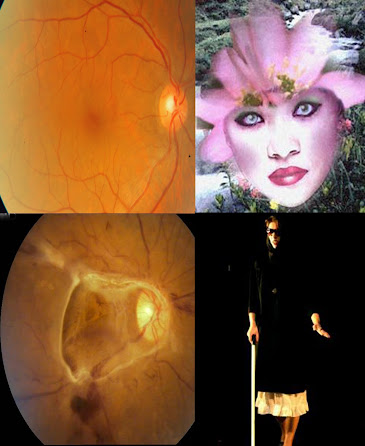COMPUTER/ PHONE and EYE
Computers
have become an essential part of life. Every one, in one or other situation,
gets the need to use computer. In the present pandemic, due to “Work From
Home” and “Online Classes”,
both the elders and Children are exposed to digital monitors like never before.
Since the computer is involved with vision and eyes, it has some effect on eye and
surrounding muscles. These, if not taken proper care of, may lead to severe
problems. It is thus essential to know how to reduce the effects of Monitors on
the eyes.
Fig. 1
Computer Vision Syndrome
The
symptoms of computer vision syndrome are: headache, tiredness, irritation of
eyes, dryness of eyes, redness, heaviness, watering, foreign body sensation
etc.
Most
of these symptoms are due to Dryness of eyes which is created by the monitor
light, and reduced blinking. There are small muscles around the eye balls (Extraocular Muscles), which help in moving our eyes. Fatigue or exertion of these Extra-ocular muscles is a cause
for symptoms like headache, brow ache etc. Inside the eye, there is a small focusing muscle (Ciliary Muscle), which helps in focusing near objects. Our eyes are naturally created for distant vision, and thus this ciliary muscle is usually relaxed. But since the eyes are more and more used for near vision, this muscle is put under undue stress. This Ciliary stress or ciliary spasm causes Eye heaviness, Eye ache, brow-ache etc. Infrequent blinking, which is
usually seen during computer use, further aggravates the dry eye, by
evaporation. The part of computer or Mobile phone or Tablet, with major effect
on eyes is the “monitor”. The monitor emits light which causes of evaporation
of tear film. The article applies to all devices like Mobile phones, Tablet
PCs, Laptop, Desktop etc. Wherever the word “Computer” is used, it applies to
all the above-mentioned devices.
Tear
film is a thin film of liquid which covers the surface of eye. This wets the
eye and nourishes it. If its depleted, eyes become dry and irritable.
Normally
we blink about 15 times per minute. Blink is very essential to reform the tear film
which breaks up before the blink. To simplify, the tear film evaporates
between the blinks, and forms during the blinks. Blinking occurs
involuntarily without our knowledge. During computer usage, the blink rate
falls down, as we are focusing on the monitor. This reduced blinking exposes
the eye surface to environment for more than normal time. Thus, the tear film
gets evaporated, leading to dryness.
The
Display of letters in the monitor should be with high contrast and low
brightness. The letters font should not be too small. Less contrast and small
fonts, make the eyes to stress more to see. This stress causes headache,
tiredness etc.
The
ambient light also plays a role. The room lights should not be too bright and
they should not directly shine light on either the eyes or the monitor.
STEPS TO
REDUCE THE SYMPTOMS:
The
only way to totally get rid of symptoms is to stop computer usage, which is not
possible in today’s life. The following ten steps would reduce the symptoms to
a major extent.
Eye strain often is
caused by excessively bright light either from outdoor sunlight coming in
through a window or from harsh interior lighting. When you use a computer, your
ambient lighting should not be very bright nor dark.
Eliminate exterior
light by closing drapes, shades or blinds. Reduce interior lighting by using fewer
light bulbs or fluorescent tubes, or use lower intensity bulbs and tubes. If
possible, position your computer monitor or screen so windows are to the side,
instead of in front or behind it.
Fig. 2. Proper Lighting
2. Minimize glare.
Glare on walls and
finished surfaces, as well as reflections on your computer screen also can
cause computer eye strain. Consider installing an anti-glare screen on your
monitor and, if possible, paint bright white walls a darker color with a matte
finish.
If you wear glasses,
purchase lenses with anti-reflective (AR) coating. AR coating reduces
glare by minimizing the amount of light reflecting off the front and back
surfaces of your eyeglass lenses.
Fig. 3. Glare minimizing
3. Upgrade your
display.
If you have not
already done so, replace your old tube-style monitor (called a cathode ray tube
or CRT) with a flat-panel LED display.
LED screens are
easier on the eyes and usually have an anti-reflective surface. Old-fashioned
CRT screens can cause a noticeable "flicker" of images, which is a
major cause of computer eye strain. Even if this flicker is imperceptible, it
still can contribute to eye strain and fatigue during computer work.
Finally, choose a
relatively large display. For a desktop computer, select a display that has a
diagonal screen size of at least 19 inches.
Fig. 4. Monitor
4. Adjust your
computer display settings.
Keep the brightness low and contrast high. Don’t use Backgrounds which
makes the visibility of letters less. Use the letters of reasonable font size.
In windows 10 use “Calibrate Display color” option. Follow the
instructions and adjust the following: 1. Gamma Correction 2. Brightness 3.
Contrast and 4. Color Balance.
Fig. 5. Calibrate the Display
5. Blink and rest.
Blinking is very
important when working at a computer; blinking moistens your eyes to prevent
dryness and irritation. Since involuntary blinking gets reduced during computer
use, try to blink voluntarily more often.
To reduce your risk
of dry eyes during computer use, try this exercise of 30-30. After every 30
minutes of computer usage, close your eyes gently for 30 seconds. This
replenishes the tear film which got evaporated during the computer usage.
Fig. 6. 30-30 Rule: 3o seconds eye
closure every 30 minutes
6. 20-20-20 Rule
Another cause of
computer eye strain is ‘focusing fatigue’. To reduce your risk of tiring your
eyes by constantly focusing on your screen follow “20-20-20 rule”: look away
from your computer at least every 20 minutes and gaze at a distant object (at
least 20 feet away) for at least 20 seconds. Looking far away relaxes the
focusing muscle inside the eye to reduce fatigue.
Fig. 7. 20-20-20 Rule
7. Exercise your eyes.
Exercise the
extraocular muscles, so that they won’t fatigue soon. Move your eyes in all
directions for 2 minutes. Do this every 3 hour.
Horizontal Eye
Movements:
Slowly Look to your Right and Left. Five times
Vertical Eye
Movements:
Slowly Look Up and Down. Five times
Rotatory Movements: Rotate eyes both in
Clockwise and Anticlockwise directions. Five times each.
Fig. 8. Eye Exercises
7. Take frequent
breaks.
To reduce your risk
for computer vision syndrome and neck, back and shoulder pain, take frequent
breaks during your computer work day. Every two hours, do the gentle neck
exercises.
8. Modify your
workstation.
If you need to look
back and forth between a printed page and your computer screen, this can cause
eye strain. Place written pages on a copy stand adjacent to the monitor.
See that your
computer screen is 20 to 24 inches from your eyes. The center of your screen
should be about 10 to 15 degrees below your eyes for comfortable positioning of
your head and neck.
Fig. 9. Workstation
9. Consider computer
eyewear
Fig. 10. Computer Glasses
10. Medications
With the advice of
your ophthalmologist, you can use artificial tear drops. There are many brands
available in the market. Basically, all of these function in the same manner.
They wet the eye surface and thus correct dryness. They work well and relieve
the symptoms quite fast, but the relief is usually temporary.
Fig. 10. Lubricant Eye Drops
Despite the above
precautions, if you happen to develop any eye symptoms, kindly consult an
ophthalmologist rather than resorting to self-medication.
Get your eyes checked
by an ophthalmologist at least, once in a year.
Follow these steps,
and start getting relieved of your computer vision syndrome problems. Happy
browsing…
Dr. Murali Mohan Gurram is Topical Vitreoretinal Surgeon and Topical Phaco surgeon. He is one of the very few ocular surgeons who can operate both Phaco and Vitreoretinal surgeries under Topical Anesthesia. With more than 20 years’ experience, his advice is something which you can surely rely on.
Dr. Murali Mohan Gurram is available at “SURALI
CLINICS” Women and Eye Care. H.
No. 12-1-86/A/149, Anand Nagar X Roads, Bandlaguda 500068,
GPS
Position: 17.369639 78.573479
Call 6303476390 for
appointment. Whatsapp 9848322436 for online consultation.
Email: suraliclinics@gmail.com
Website: www.suraliclinics.wixsite.com/sumathimuraligurram















Comments
Post a Comment